
Station Name: ABERCANAID[Source: Nick Catford]
old1.jpg) Abercanaid station looking south along the up platform c1908. Entrance to the station is from the bridge where an entrance porch gives access to the upper floor of the station building. There was a wide ramp for access to the down platform. Th station was provided with gas lighting from opening.
Copyright photo from John Alsop collection  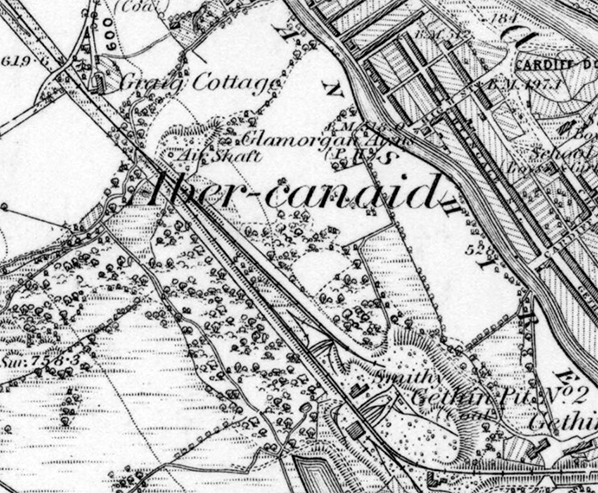 Before the opening of the Merthyr - Quakers Yard line in 1886, there was already a railway running part of the way down the west bank of the River Taff: the private Gethin Railway belonging to the Cyfarthfa Ironworks. It served the two Gethin Pits and Castle Pit and ran through what would later become Abercanaid station. Before the opening of the Merthyr - Quakers Yard line in 1886, there was already a railway running part of the way down the west bank of the River Taff: the private Gethin Railway belonging to the Cyfarthfa Ironworks. It served the two Gethin Pits and Castle Pit and ran through what would later become Abercanaid station.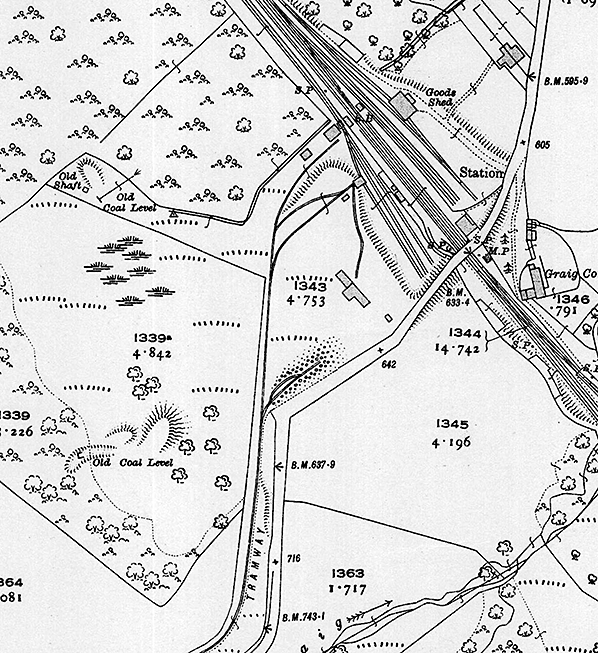
Abercanaid station had two facing platforms. The main station building was on the down side of the line with access to the upper floor from Graig Road bridge. Access to the up platform was by a curving ramp on the south side of the bridge. There was a waiting shelter on the up platform. A signal box at the north end of the up platform controlled access to the goods yard and the later Waun Wyllt Colliery sidings on the up side. The goods yard comprised three parallel sidings running behind the down platform. The east siding had a loop which ran through a goods shed. Road access to the goods yard was from the north side of Graig Road bridge. In 1908 Waun Wyllt Colliery opened to the south of the station. A narrow gauge tramway ran from the colliery drift to the station, where three new standard gauge sidings were laid down in 1907. A number of buildings were provided, one of which was a transfer shed where coal could be transferred from narrow gauge to standard gauge wagons. There was a railway weighbridge and weigh office at the north end of the sidings. A number of buildings on the site were served by the narrow gauge tramway as was a spoil tip. Click here for a larger version.
old2.jpg) A southbound train departs Abercanaid beneath Craig Road bridge and the photograph is thought to have been taken in 1922. The station platforms ended on the immediate north side of the bridge and the roof of the signal box is just visible in the background through the bridge. The sidings branching off in the foreground led to Gethin No. 1 and No. 2 collieries. The track at this location had been relaid with bullhead rail by this time, replacing the original Rhymney Railway flat bottom rail (see the website entry for Aberfan). As is clearly seen, Abercanaid station building was at street level, note the porch around the entrance. It appears passengers for northbound trains were required to cross the bridge and reach the platform via a ramp leading down from the road. Part of the fence alongside the ramp can just be discerned to the right of the locomotive's chimney. The locomotive is a Rhymney Railway 0-6-2T and given it is fitted with the vacuum brake is probably a member of the P Class. The 0-6-2T designs proliferated in South Wales, being found eminently suitable for the requirements of the various Pre Grouping railway companies in the region. Due to image quality it has not been possible to identify the rolling stock with certainty, although the vehicle coupled behind the locomotive appears to be a passenger brake van of some form while the third vehicle hints of being one of the Rhymney Railway's distinctive 'slab sided' designs. One feature which is rather prominent is the 'torpedo' ventilators on the roofs. This type of rather charismatic ventilator can still be seen at some heritage railways and museums but otherwise disappeared from passenger stock on what we now call the National Network a very long time ago and well before the advent of air conditioned stock.
Photo from Jim Lake collection old3.jpg)
Abercanaid station looking north from Graig Road bridge in May 1954, three years after closure to passengers. Apart from removal of the station lighting little seems to have changed since closure to passengers in 1951. A number of coal wagons are seen in the goods yard on the right and further coal wagons are seen in the siding beyond the signal box. Sidings on the west side of the station served the Waun Wyllt Colliery. There were standard gauge sidings as seen here and a narrow gauge tramway to the colliery.
Photo from John Mann collection old4.jpg)
Abercanaid station up platform some time during the 1950s after closure to passenger traffic in 1951. Lighting has been removed and the platform is strewn with rubbish. The buildings in the background are believed to be from Waun Wyllt Colliery which closed in 1920.
Photo from John Mann collection old5.jpg)
An interesting, but unfortunately poor quality, view over Abercanaid station facing north toward Merthyr Tydfil. The vantage point was the bridge carrying Craig Road over the railway. The photograph is undated although close examination suggests shortly before final closure in 1960, by which time only goods traffic was operating; note the two open wagons in the goods yard. Platform lighting has been removed, leaving only the stanchions, and the rail heads are quite rusted. The bracket signal in the distance has apparently lost its arm. The British Railways liveried locomotive is a 6400 Class 0-6-0PT (Pannier Tank) and while its individual identity is unclear it would appear to be No. 6416, a locomotive which happened to be at Merthyr Tydfil shed during the late 1950s and into the 1960s. She was placed into store in February 1963 and withdrawn during September of the same year. What exactly was happening is a matter of speculation. The locomotive carries an obvious lamp in front of its chimney but it is not clear if another lamp is present above the buffer beam. The clerestory vehicle is in smart condition, carrying Great Western brown and cream livery, and has windows cut into at least one end while a stove is apparently fitted. The conclusion is that it is an engineering vehicle converted from a Passenger Brake Van of the Dean era. Two men can be seen standing on the platform behind the train while there appears to be somebody in the signal box, which had perhaps been downgraded to ground frame status by this time. The goods shed and yard can be seen on the right. The shed has the usual, for rural stations, single road running through and two other roads can be seen between the shed and station platform.
Photo from John Mann collection 1.jpg) After total closure of the line in 1960 the platform buildings were demolished and the track lifted. The main station building lingered for some years. Coal was taken out of the tips to the north of the station and waste from this operation gradually washed down and filled the track bed between the platforms. In this view from 1973 only the north end of the down platform remains visible.
Photo by Nick Catford 2.jpg) By January 1976 extraction of coal from adjacent tips the station area was thick with deep mud with any surviving platform remains buried. By January 1976 extraction of coal from adjacent tips the station area was thick with deep mud with any surviving platform remains buried.Photo
by John Mann
3.jpg) The A470 dual carriageway was built between the M4 and Abercynon in the 1960s and 1970s. It was extended north between Abercynon and Pentrebach in the 1980s utilising part of the former Quakers Yard to Merthyr line north of Aberfan. The road was further extended north in the 90s with the Merthyr Expressway, as it is now known, opening between Pentrebach and Merthyr in 1996. In the mid 1980s the trackbed was cleared around Abercanaid to allow road building materials to be brought to the site. This view is looking north at the site of Abercanaid station. If the platforms survived at this time they were buried. The A470 dual carriageway was built between the M4 and Abercynon in the 1960s and 1970s. It was extended north between Abercynon and Pentrebach in the 1980s utilising part of the former Quakers Yard to Merthyr line north of Aberfan. The road was further extended north in the 90s with the Merthyr Expressway, as it is now known, opening between Pentrebach and Merthyr in 1996. In the mid 1980s the trackbed was cleared around Abercanaid to allow road building materials to be brought to the site. This view is looking north at the site of Abercanaid station. If the platforms survived at this time they were buried.Photo by John Mann 4.jpg)
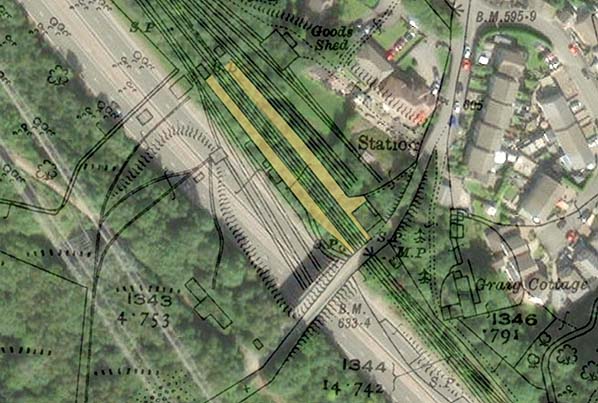
Abercanaid station overlaid onto a recent aerial photo of the site. The platforms are coloured yellow and are now lost under the embankment on the east side of the road. Click here to see a larger version.
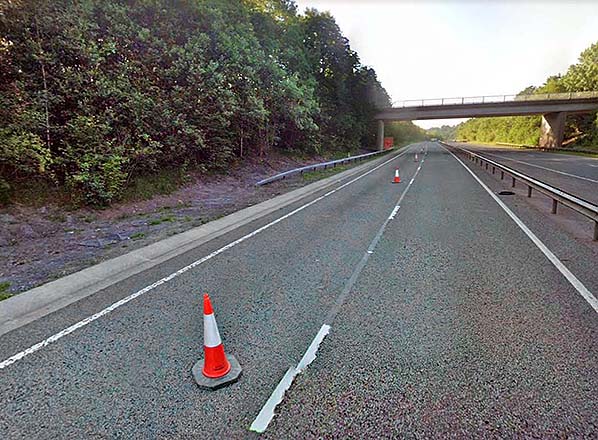
Looking south east along the Merthyr Expressway in summer 2022. The road passes through the site of sidings on the east side of the station. The site of the station is buried under the embankment on the left. Graig Road bridge replaces the original bridge which was immediately east of the new bridge.
Photo by Celia Brent
|
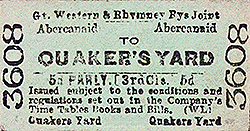 A signal box stood at the north end of the up platform. This controlled access to the goods yard on the down side of the line and coal sidings on the up side. The goods yard comprised three parallel sidings running behind the up platform up to Graig Road. A loop ran off the furthest siding east through a goods shed. The shed was of stone construction with a pitched roof and a canopy over its east side to offer weather production for unloading/loading road vehicles. One of the sidings served Crawshay Brothers (Cyfartha) Ltd who owned the Cyfartha Ironworks. Road access to the yard was from Graig Road. The yard only handled general goods, parcels and coal and had no facilities for livestock. Somewhere in the yard there was a 1 ton 10 cwt capacity crane. Sidings immediately south of Graig Road bridge led to Gethin No. 1 and Gethin No. 2 collieries. Gethin Collieries had a private miners’ platform in use between 1915 and 1928.
A signal box stood at the north end of the up platform. This controlled access to the goods yard on the down side of the line and coal sidings on the up side. The goods yard comprised three parallel sidings running behind the up platform up to Graig Road. A loop ran off the furthest siding east through a goods shed. The shed was of stone construction with a pitched roof and a canopy over its east side to offer weather production for unloading/loading road vehicles. One of the sidings served Crawshay Brothers (Cyfartha) Ltd who owned the Cyfartha Ironworks. Road access to the yard was from Graig Road. The yard only handled general goods, parcels and coal and had no facilities for livestock. Somewhere in the yard there was a 1 ton 10 cwt capacity crane. Sidings immediately south of Graig Road bridge led to Gethin No. 1 and Gethin No. 2 collieries. Gethin Collieries had a private miners’ platform in use between 1915 and 1928.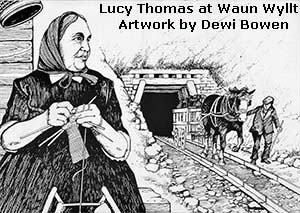 The original Waun Wyllt mine (or Abercanaid Level) was opened by Robert and Lucy Thomas about 1824 (SO045040) and became the first to mine the 4 foot seam of steam coal which was supplied to households in Merthyr and Cardiff. A short tramway was built from Thomas's Level to the Glamorgan Canal. After Robert's death, his wife Lucy took over the business and it wasn't long before coal was being shipped to London. Lucy became known as 'the mother of Welsh steam coal trade'. Lucy Thomas moved from Waunwyllt Level in the mid 1830s when the lease ran out and she continued her business by leasing the 60 yard deep Graig pit nearby. This mine closed in 1870. The Thomas Merthyr Colliery Company opened another Waun Wyllt Level in 1909 at Nant Graig (SO049034) just west of Abercanaid station.
The original Waun Wyllt mine (or Abercanaid Level) was opened by Robert and Lucy Thomas about 1824 (SO045040) and became the first to mine the 4 foot seam of steam coal which was supplied to households in Merthyr and Cardiff. A short tramway was built from Thomas's Level to the Glamorgan Canal. After Robert's death, his wife Lucy took over the business and it wasn't long before coal was being shipped to London. Lucy became known as 'the mother of Welsh steam coal trade'. Lucy Thomas moved from Waunwyllt Level in the mid 1830s when the lease ran out and she continued her business by leasing the 60 yard deep Graig pit nearby. This mine closed in 1870. The Thomas Merthyr Colliery Company opened another Waun Wyllt Level in 1909 at Nant Graig (SO049034) just west of Abercanaid station.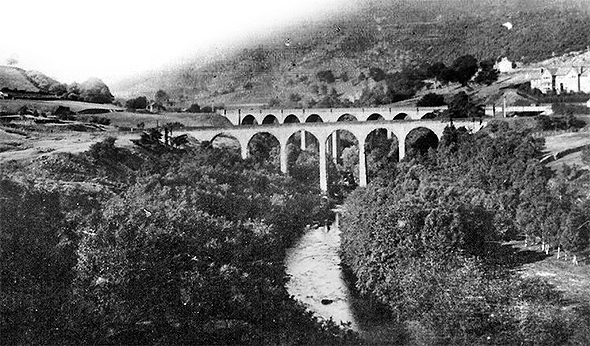 Quakers Yard viaducts No 2 (foreground) and No 3. From Quakers Yard station a line passed over the second viaduct before entering a tunnel to reach the Cynon Valley below Aberdare from where it ran on to Neath and Swansea. The Rhymney Railway, later diverged from the Swansea line at Quakers Yard running along the west bank of the River Taff. This required the building of a third viaduct, parallel to the second but curving away northwards towards Merthyr from it. Both viaducts have now been demolished.
Quakers Yard viaducts No 2 (foreground) and No 3. From Quakers Yard station a line passed over the second viaduct before entering a tunnel to reach the Cynon Valley below Aberdare from where it ran on to Neath and Swansea. The Rhymney Railway, later diverged from the Swansea line at Quakers Yard running along the west bank of the River Taff. This required the building of a third viaduct, parallel to the second but curving away northwards towards Merthyr from it. Both viaducts have now been demolished.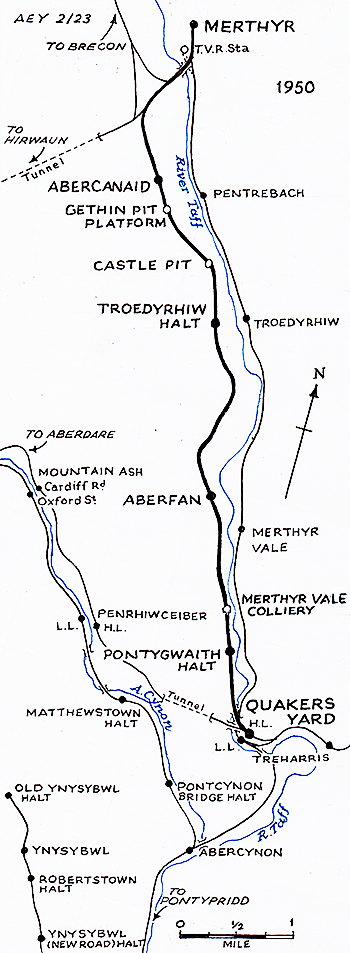 Although the GWR already had a presence at Merthyr through the Vale of Neath line, up to that point the Taff Vale Railway had a monopoly of the direct routes from Merthyr to the south and east.
Although the GWR already had a presence at Merthyr through the Vale of Neath line, up to that point the Taff Vale Railway had a monopoly of the direct routes from Merthyr to the south and east.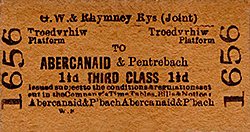 One additional new station at Troedyrhiw was opened on the Quakers Yard to Merthyr line on 18 February 1907 to make use make use of these 'cars' (renamed Troedyrhiw Halt in 1924). The 'cars' were not a success; one was rebuilt in 1910, making a separate carriage and engine. The other was used until 1919 on the Penrhiwfelin workmen's train, and then modified in the same way as the other. Another new station, Pontygwaith Halt opened 11 September 1933. There were also a number of private and untimetabled stations for colliery workers. Gethin Pits Platform was in use between 1915 and 1928 and Castle Pit Platform was in use between 1897 and 1915. There was also a Merthyr Vale Miners Platform at the junction with the branch to the collieries.
One additional new station at Troedyrhiw was opened on the Quakers Yard to Merthyr line on 18 February 1907 to make use make use of these 'cars' (renamed Troedyrhiw Halt in 1924). The 'cars' were not a success; one was rebuilt in 1910, making a separate carriage and engine. The other was used until 1919 on the Penrhiwfelin workmen's train, and then modified in the same way as the other. Another new station, Pontygwaith Halt opened 11 September 1933. There were also a number of private and untimetabled stations for colliery workers. Gethin Pits Platform was in use between 1915 and 1928 and Castle Pit Platform was in use between 1897 and 1915. There was also a Merthyr Vale Miners Platform at the junction with the branch to the collieries.
 Home Page
Home Page